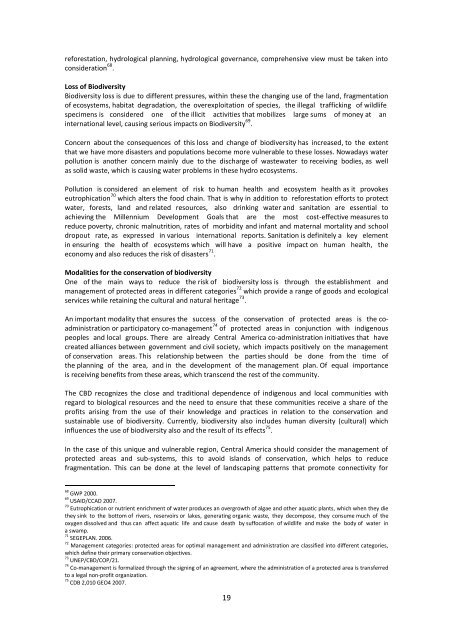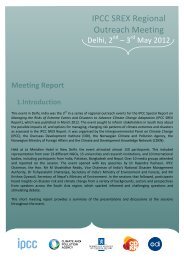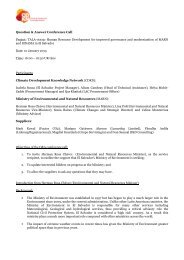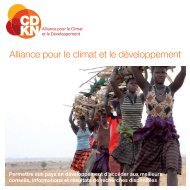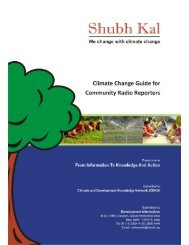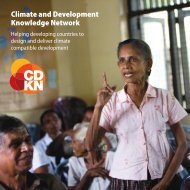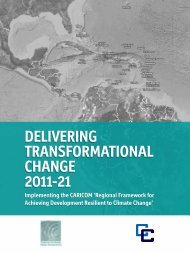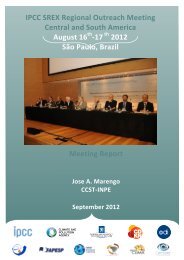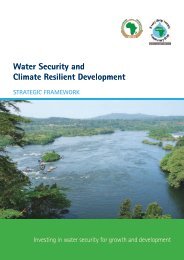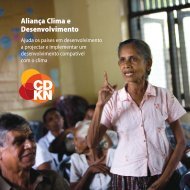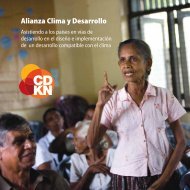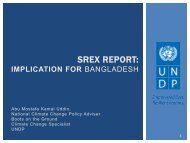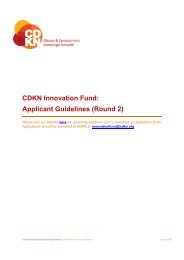pollination of plants, including many crops, the contribution to the hydrological cycle, and also spiritual,cultural and aesthetic benefits 60 .All these benefits are unique and irreplaceable but it is worth highlighting the fact that biodiversitycontributes to climate because, as indicated aids stabilization and climate moderation, extremetemperatures, as well as to events extreme hydrometeorological (floods and droughts).An example for disaster risk reduction is the conservation of mangroves 61 which help reduce or preventimpacts from extreme events. Mangroves play a vital role in protecting against coastal storms(hurricanes, typhoons) and tsunamis (stabilization of coastal areas), it helps to prevent erosion, aresystems of early protection against the rise average sea level. Indeed, the maintenance of these coastalwetlands is vital to prevent the flooding of ports and cities to be an effective way to reduce the risk offlood disasters 62 .Another important strategy to reduce the risk of drought disaster is through the conservation ofagricultural biodiversity. It is therefore important to promote opportunities for indigenous and localcommunities to participate in the development, implementation and local management of nationalbiodiversity strategies, action plans and programmes on agricultural biodiversity 63 .There are examples of local species that adapt to the changing environment and also have ahigh nutritional value, are species that do not require inputs which means that it reduces impacts bypollutants into the atmosphere and soil; they are accessible, easy to reproduce, and further strengthensits identity with social groups in the region, rescuing cultural values.The CBD recognizes the close and traditional dependence of indigenous and local biologicalresources and the need to ensure that these communities will receive part of the benefits derivedfrom the recognition and respect of their knowledge and traditional practices with regard to theconservation and sustainable use of biological biodiversity. Currently, biodiversity also includes humandiversity (cultural) which influences its use and therefore the impact of its effects 64 . Central Americabeing rich in biological and cultural diversity has a great opportunity to link these particularities incompliance with the objectives of the Convention on Biological Diversity 65 .Finally, we want to highlight the importance of basins, for the conservation of Biodiversity, and alsowater provisions for different uses of the various stakeholders and sectors of society. However,nowadays, the basins are also conductive of pollution solids and solids drag due to the lack of watershedmanagement, extending these problems to the sea, creating a potential disaster risks. Disasters asmanifestations of risk from its impacts are defined territorial boundaries. Many times, the "territory ofcausality" tends to differ substantially from the "impact area" even though when compared with otherunique factors they may coincide. This becomes important especially when it comes to administrativeunits or even to different national territories such as water basins 66 .In that sense, it is important to consider the Integrated Water Resources Management (IWRM) 67 as astrategy for adaptation and for disaster risk reduction. In the basins large impacts are provoked due todeforestation and washing of sediments causing flooding downstream. Therefore another strategy toreduce vulnerability must be initiated through the integrated watershed management, where60 GEO4 2007.61 Mangroves are also the core of the food chain for most of the commercial species; also add nutrients that go to the continentalplatform by supporting the feeding of other species are of value as feeding sites for migratory birds among others. In this regardits hydrobiological importance is immeasurable.62 JICA/TNC 2009.63 Von Humboldt. 2009.64 CDB 2,010 GEO4 2007.65Convention on Biological Diversity (CBD) has three main goals: the conservation of biodiversity, sustainable use ofcomponents of biodiversity and the fair and equitable sharing of benefits arising from the use of genetic resources.66 Central American Policy on Integral Risk Management, 2010.67 GIWRM: A process that promotes the coordinated development and management of water, land and related resources, in orderto maximize the resultant economic and social welfare in an equitable manner without compromising the sustainability of vitalecosystems.18
eforestation, hydrological planning, hydrological governance, comprehensive view must be taken intoconsideration 68 .Loss of BiodiversityBiodiversity loss is due to different pressures, within these the changing use of the land, fragmentationof ecosystems, habitat degradation, the overexploitation of species, the illegal trafficking of wildlifespecimens is considered one of the illicit activities that mobilizes large sums of money at aninternational level, causing serious impacts on Biodiversity 69 .Concern about the consequences of this loss and change of biodiversity has increased, to the extentthat we have more disasters and populations become more vulnerable to these losses. Nowadays waterpollution is another concern mainly due to the discharge of wastewater to receiving bodies, as wellas solid waste, which is causing water problems in these hydro ecosystems.Pollution is considered an element of risk to human health and ecosystem health as it provokeseutrophication 70 which alters the food chain. That is why in addition to reforestation efforts to protectwater, forests, land and related resources, also drinking water and sanitation are essential toachieving the Millennium Development Goals that are the most cost-effective measures toreduce poverty, chronic malnutrition, rates of morbidity and infant and maternal mortality and schooldropout rate, as expressed in various international reports. Sanitation is definitely a key elementin ensuring the health of ecosystems which will have a positive impact on human health, theeconomy and also reduces the risk of disasters 71 .Modalities for the conservation of biodiversityOne of the main ways to reduce the risk of biodiversity loss is through the establishment andmanagement of protected areas in different categories 72 which provide a range of goods and ecologicalservices while retaining the cultural and natural heritage 73 .An important modality that ensures the success of the conservation of protected areas is the coadministrationor participatory co-management 74 of protected areas in conjunction with indigenouspeoples and local groups. There are already Central America co-administration initiatives that havecreated alliances between government and civil society, which impacts positively on the managementof conservation areas. This relationship between the parties should be done from the time ofthe planning of the area, and in the development of the management plan. Of equal importanceis receiving benefits from these areas, which transcend the rest of the community.The CBD recognizes the close and traditional dependence of indigenous and local communities withregard to biological resources and the need to ensure that these communities receive a share of theprofits arising from the use of their knowledge and practices in relation to the conservation andsustainable use of biodiversity. Currently, biodiversity also includes human diversity (cultural) whichinfluences the use of biodiversity also and the result of its effects 75 .In the case of this unique and vulnerable region, Central America should consider the management ofprotected areas and sub-systems, this to avoid islands of conservation, which helps to reducefragmentation. This can be done at the level of landscaping patterns that promote connectivity for68 GWP 2000.69 USAID/CCAD 2007.70 Eutrophication or nutrient enrichment of water produces an overgrowth of algae and other aquatic plants, which when they diethey sink to the bottom of rivers, reservoirs or lakes, generating organic waste, they decompose, they consume much of theoxygen dissolved and thus can affect aquatic life and cause death by suffocation of wildlife and make the body of water ina swamp.71 SEGEPLAN. 2006.72 Management categories: protected areas for optimal management and administration are classified into different categories,which define their primary conservation objectives.73 UNEP/CBD/COP/21.74 Co-management is formalized through the signing of an agreement, where the administration of a protected area is transferredto a legal non-profit organization.75 CDB 2,010 GEO4 2007.19
- Page 3 and 4: Executive SummaryCentral America is
- Page 5 and 6: Central is located in the "Ring of
- Page 7 and 8: Study ContentAs an innovative theme
- Page 9 and 10: that coexist in the universe. This
- Page 11 and 12: Central America level, is the only
- Page 13 and 14: of Mesoamerica has been explained a
- Page 15 and 16: possesses effective cultural commun
- Page 17: Additionally, to succeed and achiev
- Page 21 and 22: General thematic introduction on Cl
- Page 23 and 24: Central American Governments should
- Page 25 and 26: projected 109 conditions, changes o
- Page 27 and 28: General introduction on the themati
- Page 29 and 30: participatory manner, to address di
- Page 31 and 32: Causes and complementary consequenc
- Page 33 and 34: Organizational and legal contextWhi
- Page 35 and 36: The three bodies within the SICA ar
- Page 37 and 38: Based on research of available info
- Page 39 and 40: SE-CONREDCivilProtectionSNETCCNISCO
- Page 41 and 42: Synergy model that displays the add
- Page 43 and 44: Added value of indigenous and local
- Page 45 and 46: They do not work in a separate mann
- Page 47 and 48: demand for agricultural raw materia
- Page 49 and 50: Amazon DIPECHO Project “Strengthe
- Page 51 and 52: Indigenous Knowledge on DisasterMit
- Page 53 and 54: The combination of indigenous andsc
- Page 55 and 56: Indigenous Skills and the mysticism
- Page 57 and 58: Weather forecast through indigenous
- Page 59 and 60: In various international convention
- Page 61 and 62: Recommended ReadingBennett, A., 200
- Page 63 and 64: ILO, 1993, Convenio sobre pueblos i
- Page 65 and 66: Local knowledgeIncludes people and
- Page 67 and 68: which are threatswith a certainprob
- Page 69 and 70:
Appreciates and respects their orga
- Page 71 and 72:
framework, without taking into acco
- Page 73 and 74:
Currently Cacaopera ethnicity, alth
- Page 75 and 76:
IDH 228 For 2007 is of 0.6999Politi
- Page 77 and 78:
The Mayangnas are people who are de
- Page 79 and 80:
Rights of detainees to receive info
- Page 81 and 82:
Heritage Protection Article 128The
- Page 83 and 84:
19/09/1996 Law no. 230 Amendments a
- Page 85 and 86:
Indigenous Population:IDH 241 In 20
- Page 87 and 88:
Honduras, each has a different orig
- Page 89 and 90:
MISQUITOS 248 :In 1996 there were 3
- Page 91:
Internationalconventions signed wit


